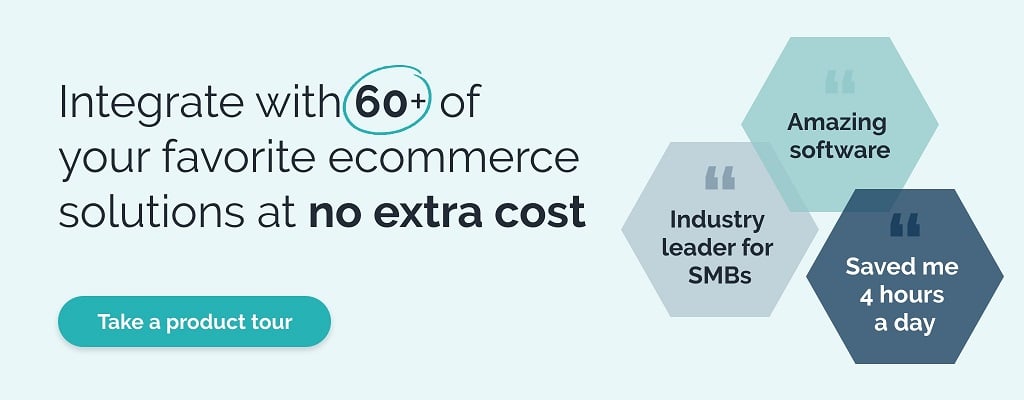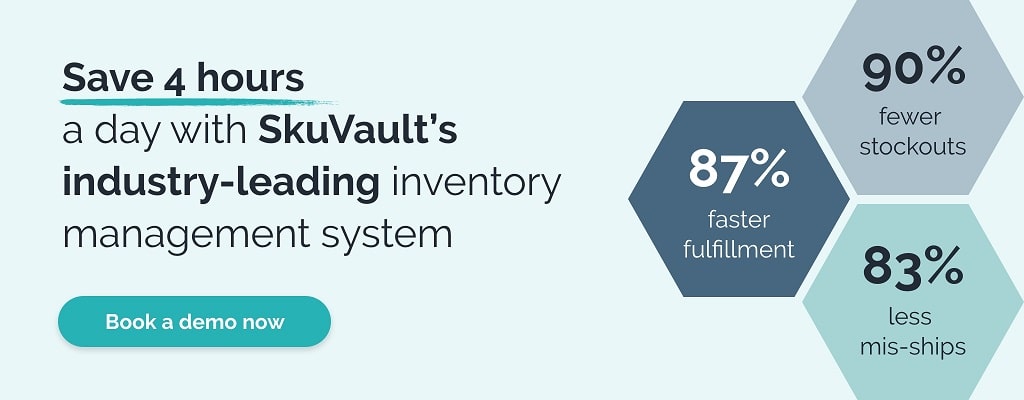How much does a 3PL cost: learn if 3PL fees are worth the benefits
Third-party logistics (3PL) companies charge businesses, such as ecommerce companies, a variety of different fees based on the services provided to fulfill their orders. The total expense your company would pay a 3PL primarily breaks down into four different categories of fees:
- Receipt of your inventory
- Warehouse and storage
- Picking and packing, and
- Outbound shipping expenses
The specific cost of these services depends on a wide variety of factors, including but not limited to your order volume and any special services your ecommerce business might require, such as handling and shipping of oversized items or inventory that needs to be refrigerated or kept in a climate-controlled environment.
Your logistics partner can also provide upgraded services such as custom branded or eco-friendly shipping boxes, as well as kitting (assembling items).
And, as with most services, the greater a business’s order volume, the lower its per item costs will generally be.
The good news is that working with a 3PL can greatly reduce your ecommerce company’s expenses in many key areas and free you up to focus on scaling your business, increasing your product line, and expanding your market. However, partnering with a 3PL does come with a cost.
Are 3PL fees worth the benefits? Let’s take a closer look.
What is an order fulfillment fee?
Order fulfillment is the primary service your 3PL partner provides. Order fulfillment fees are the expenses you would pay to your logistics partner for services including:
- Receiving your inventory
- Storing your products in their warehouse
- Processing your orders via various shopping cart platforms
- Picking, packing, and shipping
- Processing your returns
Of course, these common order fulfillment fees may vary due to a variety of factors, including your 3PL provider’s pricing model, your order volume, and any additional or special services your business may require.
In order to determine which logistics company is best for your ecommerce business, you’ll want to familiarize yourself with the various pricing models and fulfillment fees that may apply.
What does cost per order mean?
Standard pick and pack fees generally start at approximately $.20 per item. That said, there are other factors your ecommerce business will need to consider as you analyze what your ultimate cost per order will be and whether or not a 3PL makes sense for your business.
In order to calculate your business’s fulfillment costs per order, you’ll need to contemplate order fulfillment expenses and fees.
3PL pricing models
While most 3PLs use variable models for pricing, some are offering other options. When choosing a logistics partner, the pricing model will likely be a significant consideration in your decision.
Flat-rate pricing
Unlike a variable plan with a variety of 3PL rates, flat-rate plans charge per order, by shipment, or month. This fee incorporates contracted services, such as storage, fulfillment, kitting, shipping, customer service, and customer returns.
Pricing by kit
For your inventory that is stored in separate parts but needs to be combined when it is ordered by the customer, your logistics company may charge a separate fee for this service, depending on the complexity of the assembly.
Pricing per bin, shelf, or pallet
The most cost-effective option is generally storing your inventory by the pallet, which costs approximately $5 to $15 per pallet per month.
If you prefer to pay your storage fees by the cubic foot (and your logistics partner offers that service), this option generally costs between $.30-$.55 per cubic foot each month
Small items may require storage in individual bins to make them more accessible for rapid fulfillment. When this is necessary for your ecommerce business, the cost generally fluctuates between one dollar to $2.50 per month per storage bin required.
Pricing on a project basis
3PLs often work with organizations executing crowdfunding campaigns that need to contract for services based on a specific project rather than on an ongoing basis.
Pass-through pricing
3PL providers pass through wholesale (interchange) rates to customers, charging a discount rate and transaction fee above interchange.
Typical 3PL service fees
Most logistics companies charge the same types of fees, such as storage and picking, which will vary depending on:
- The 3PL you select
- Their warehouse size and location
- Your ecommerce business’s order volume
- The size and weight of your products
- Any assembly or kitting your require
- Other considerations
Across the board, storage and warehousing will generally be your biggest expenditures. While there are overall pricing ranges for the many services 3PLs offer, there are no standardized fees for fulfillment because so many variables must be taken into consideration. This means it’s important to find the 3PL partner and pricing model that works best for your ecommerce business’s specific needs.
While no ecommerce businesses are exactly alike, we know you have questions about how much logistics companies typically charge.
Here are some estimates to get you started:
Onboarding
When you begin your partnership with a logistics firm, they will likely charge you a one-time onboarding fee, averaging around $550 for small ecommerce businesses.
The typical range starts at around $100 for the smallest ecommerce business, to upwards of several thousands of dollars for larger, more complex businesses.
The onboarding charge covers integrating your online store or stores with the 3PL’s warehouse management system (WMS), creating the storage infrastructure for your business, and training the staff to handle your orders.
Set-up
Every ecommerce business, including yours, is unique. Because all businesses have different needs and processes, most logistics companies will charge an initial set-up fee.
Set-up fees are a one-time payment when your account is initially established and generally range between $100 to $1000, depending on the size of your ecommerce company and the complexity of your business.
Inbound shipping and receiving
Your logistics company’s fulfillment warehouse manages your inventory from when it first arrives at the warehouse.
Inbound shipping and receiving fees generally cover all services related to managing your inventory, including:
- Unloading your stock
- Counting and sorting your inventory
- Entering your items into the WMS
- Placing the items in the warehouse to make them available for picking and packing
These inbound shipping and receiving fees are typically charged either by the hour, ranging from $20-$50 per hour, or on a per-unit basis, which is charged at $5 to $15 per pallet, or $.25 per item.
Storage and warehousing
Your 3PL will charge you for the warehouse space needed to keep your inventory safe until it is shipped to your customer.
Your inventory storage fees are typically based on the amount of space your stock requires in the warehouse. Of course, logistics companies’ pricing structures do vary, depending on your inventory needs and their pricing model.
Box and packaging
While box and other packaging fees are often included in the order fulfillment fee, oversized or customized items such as eco-friendly or custom printed packaging may add $.25 to $2.00 per shipment.
Pick and pack
Pick and pack fees cover the process of selecting (picking) individual products within the warehouse and packing them for shipment to the customer.
It is quite common for the pick and pack fee, also called order fulfillment charges, to cover both the picking and packing, as well as the standard shipping materials needed to do so.
Some logistics providers break out these costs and also charge for packing materials, as well as pick and pack, separately. These are typically billed using either a flat fee or a base charge, plus an individual item cost.
To give you an idea of these expenses, the average package price with single item packaging is generally less than three dollars for B2C merchants and comes in around $3.75 for B2B customers.
Label printing and order insert
Label printing or order inserts are an additional charge and may cost $.10 or more per shipment.
Shipping charges
Generally speaking, your ecommerce company will have the option to either use your own preferred shipping carrier account or utilize your 3PL‘s carrier account to pay for the cost of shipping orders to your customers.
There are benefits to both choices.
Using your own shipping account can give your business additional transparency and control, while using your logistics company’s shipping account may offer discounted shipping (between 10% – 30%) due to the 3PL‘s higher shipping volumes.
Either way, shipping costs are calculated on the size and weight of your products.
Work orders
Work orders are hourly charges based on how long it takes an employee to accomplish a task. Work orders cover activities that are not included in existing fees, such as mislabeled items or asking warehouse workers to “check” on something.
Returns
Return fees, or reverse logistics, are expenses associated with accepting customer returns.
Return costs can include return shipping charges and a processing fee of approximately $1 to $3.50 for inspection, restocking, or disposal if necessary.
Account management
You’re a 3PL Will also add a flat fee to your monthly service to cover account management activities needed for your ecommerce business account.
This includes services such as customer service calls, supply chain management, and other activities outside of order fulfillment.
You can expect to pay between $75-$250 per month if you choose a flat rate for your account services or between $40-$60 per hour.
How to calculate fulfillment cost per order
If you’d like to calculate your approximate fulfillment cost per order, this handy guide should help you get a better idea of what your expenses might be.
Total Warehouse Storage Fee = Number of pallets x storage fee per pallet
Total Pick & Pack Fee = (Number of orders per month x Pick & Pack fee per order) + (Number of units per month x Pick & Pack fee per unit)
Total Receiving Fee = Number of units received every month x receiving fee per unit
__________________________________________________
Total Monthly Fee = Total Warehouse Storage Fee + Total Pick & Pack Fee + Total Receiving Fee
TOTAL Fee Per Order = Total Monthly Fee ÷ Number of Orders Per Month
Final thoughts
Whether your ecommerce business is looking to scale or expand, 3PLs may offer effective solutions and opportunities for both improved customer service as well as lower costs for order fulfillment.
Because the inventory, size, complexity, and order volume vary so much between businesses, it’s challenging to estimate how much working with a 3PL will cost without a call or meeting to discuss your ecommerce business’s needs against the offerings of your potential 3PL partners.
FAQs
The cost of third-party logistics (3PL) services varies significantly based on industry and the type of products being handled. Industries with specialized products, such as pharmaceuticals or perishable goods, may incur higher costs due to the need for specialized storage and handling requirements.
When comparing quotes from multiple 3PL providers, businesses should consider factors such as service level agreements (SLAs), scalability, technology integration capabilities, and the provider’s reputation for reliability and customer service. Ensuring the provider aligns with the company’s operational needs and long-term goals is crucial for obtaining the best value.
To calculate potential cost savings and return on investment (ROI) from outsourcing logistics to a 3PL, businesses should conduct a comprehensive cost-benefit analysis. This includes comparing the total costs of in-house logistics operations, such as labor, warehousing, technology, and transportation, against the fees charged by the 3PL. Additionally, businesses should consider the potential benefits of outsourcing, such as increased efficiency, reduced capital expenditure, and the ability to focus more on core business activities.

